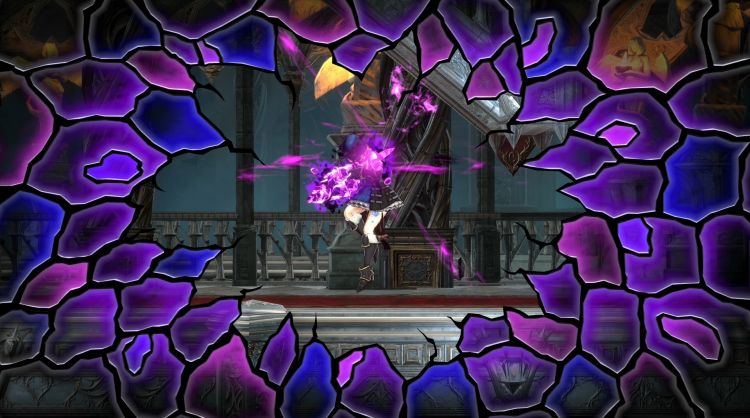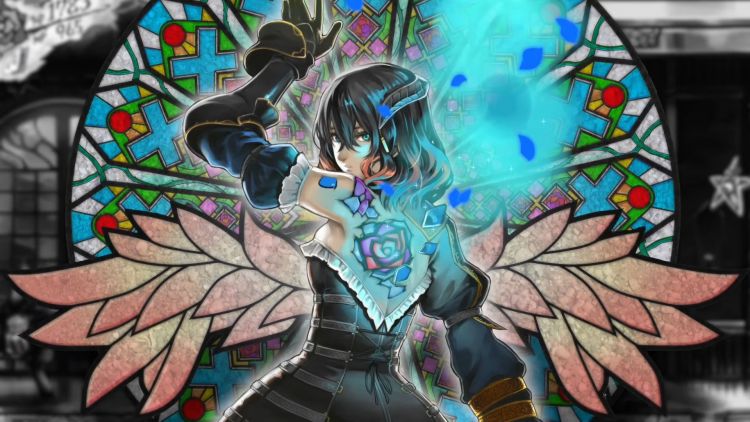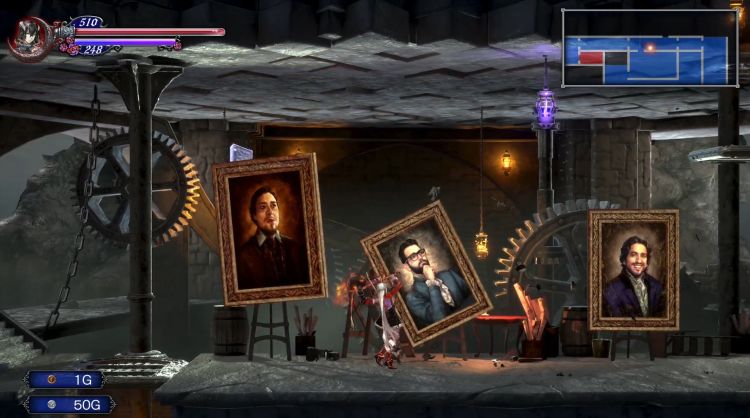Ok, I need a moment of truth here. Prior to the official release of Bloodstained: Ritual of the Night, I had written this game off completely. After being burnt by another Kickstarter funded title, and after playing several builds of the game. I simply wasn’t convinced that IGA and crew could provide me with what I was craving. A spiritual successor to Castlevania that was fun and would keep me playing until the credits rolled. Well, I was wrong. So very wrong and Bloodstained: Ritual of the Night is damned good. I’m not too proud to admit when I’m wrong.
Game Name: Bloodstained: Ritual of the Night
Platform(s): PC (reviewed), PS4, Xbox One, Switch
Publisher(s): 505 Games
Developer(s): ArtPlay, DICO, WayForward Technologies
Release Date: June 18th, 2019 / June 25th, 2019 (Switch)
Price: $39.99
** Reviewer did contribute to the Kickstarter for this title **
In Bloodstained: Ritual of the Night, you’re placed into the role of Miriam, a poor unfortunate soul who was subjected to a cruel experiment. One that resulted in crystals tuned to demonic powers being embedded in her being. Or a Shardbinder, as she’s called. Following this experiment, she fell into a deep slumber for many years. That is until this evil-looking castle appeared out of nowhere and an old friend, Gebel, decided he was going to go raise an army of demons. Having been subjected to the same treatment as Miriam, he’s a bit frustrated with the world. Of course, Miriam being the protagonist, she can’t let that sit and thus begins the story.
The story is typical; you’re here to save/stop a former friend while trying to put an end to this accursed castle. As for Miriam, she’s supposedly also playing with her own fate. Initially, it’s stated that if you absorb too many shards you might lose your humanity and suffer some consequences. Sadly, nothing really developed from that, and I felt that was a missed opportunity in my book. Hopefully, this comes back to the forefront in possibly some DLC or even another chapter in the game series. As for the characters, they were forgettable served only to assist Miriam in her quest. That is with the exception of the character voiced by David Hayter (Solid Snake). I’m patiently waiting for when we’ll be able to play him as a DLC character. Dare I say; he was more memorable than Miriam was, even though he had less time in the spotlight.
Bloodstained foregoes the conventional power-up mechanics by introducing a unique spin on acquiring abilities. Instead of leveling up and learning new abilities as you progress up the experience ladder, you instead earn them by killing enemies. Which randomly will drop a specific ability, which embeds itself into Miriam as she lets out a blood-curdling scream while it binds with her. The result is instant power-ups, and due to the sheer amount of enemies in the game, there are a lot of those to collect, with some abilities being more useful than others, while some being damned near overpowered.
It also means there are plenty of different ways you can attack, and there’s something here that everyone is going to get attached to. As for me, I find that using two specific shards ends up being a really powerful combo for melting bosses really quick. Outside of the shard system, you have your typical melee and ranged attacks thanks to an assortment of swords, whips (YEAH!) spears, hammers, knives, axes, boots, and even guns. Yes, you can, if you choose to, equip Miriam with a gun and go to town. Every weapon handles differently, many of which have special attacks that can be utilized by performing certain inputs.

Along the way, you’ll encounter several NPCs that serve as quest givers and merchants, all of which help add some variety outside of the main story. While one will have you working on your culinary skills to create delights and feed them to her for exchange of items. The other is a really pissed-off woman who wants you to kill every demon you find to avenge her family and friends. Even her gesture shows how upset she is; it’s downright hilarious.
Then there’s the crafting system that lets you craft all sorts of helpful things. Such as foods that serve to provide permanent buffs, armors, weapons, potions, even upgrading and creating new shards. It’s actually really robust, to the point that it can be overwhelming at times. The more time you invest with the crafting system, the more you’re rewarded with higher-level items and unique gear that will help you progress through the game. Especially the ability to upgrade your shards, which can turn you into a killing machine if you put the time into locating the materials needed. Sure, you can forgo using the crafting system, as it is a time sink. However, this is the only way to gain access to the more powerful gear and abilities in the game.
The star of the game is the massive castle and locations that the game takes place in. It’s easily larger than anything from the Castlevania series and most Metroidvania titles. Lots of areas to travel, along with a fair amount of puzzles that you’ll need to solve in order to continue you on. Of course, it wouldn’t be Metroidvania game without hidden stuff, and there’s plenty here, as well as a nice throwback for those who can get 99% complete the map. I won’t spoil what it is, but I’m sure fans of IGA’s past works will enjoy it. There’s also a nice number of boss fights, ranging from fairly trivial to just enough challenge to make it worthwhile. Still, part of me wishes the map was just a bit larger as I really enjoyed the experience of hunting down every area. Then again, Metroidvania games are one of my favorite gaming genres.
The visuals are quite impressive, even though at first I wasn’t a fan. Once I started making my way into the game, I started noticing more and more how the art style ended up working quite nicely. The only exceptions are the many palette swaps of the creatures and demons in the game. Other than this, Bloodstained is one of the better-looking games in this genre. The music, on the other hand, is godly. There wasn’t one track that didn’t sound out of place and there were times I would just clear out the enemies and just sit and listen. Everything was eerily familiar, but for a good reason. Michiru Yamane, the composer who’s been involved with a number of Castlevania games, has been brought on to work on the soundtrack. Even after all this time, she hasn’t missed a beat and has composed an amazing soundtrack. I’m really regretting not picking up the digital soundtrack.
It’s taken me about 16 hours to reach the good ending and finishing off the entire map. Once I killed off the final boss and cleaned up the rest of the optional content, it wasn’t the end. In typical IGAvania fashion, there are several unlocks that open up after the credits roll. Such as a sound mode that lets you listen to the soundtrack, voiced segments, and special messages by backers as narrated by David Hayter. Then there’s the boss rush mode that pits you against various bosses from the game. While the speed run mode is a nice addition to see just how fast you can beat the game in one sitting. It’s worth mentioning that the speed run mode won’t let you use an existing save and forces you to use a new one. In the event that you stop playing that speed run, it erases the temporary save.

There have been some issues with the game that I’ve noticed. Such as drops from slain creatures will either get stuck in the air or unreachable areas. Or when those same slain creatures continue to move around the screen after death. There was also some occasional slowdown. I also wasn’t a fan of the save system, as it requires you to save at checkpoints. I get that this game was going for an old-school feel. However, should the game crash or something silly should happen. Well, you lose all your progress, which could deter some people from continuing on. An auto-save system would have been appreciated. Other than that, my time with Bloodstained was very enjoyable. Not once did the game crash, and since I played on the PC I didn’t encounter the game-breaking bug that affected the PS4 and Xbox One versions.
In the end, Bloodstained: Ritual of the Night is IGA’s modern-day Castlevania, a series that has been long dead by Konami standards. I wouldn’t say it surpasses IGA’s past works; instead, it just goes to show how impressive his previous games were and how they still shine to this day. Which makes you wonder that if he was still working on the Castlevania series, is this what it would have become? Either way, Bloodstained: Ritual of the Night will go down as one of my favorite Metroidvania’s.
Bloodstained: Ritual of the Night
Summary
Bloodstained: Ritual of the Night, for lack of a better description is a modern-day Castlevania game. It’s typical Koji Igarashi gameplay at its finest and fans of his works will find everything here very familiar. Lots of stuff to do, enjoyable gameplay and a game that has more than enough to offer fans of the genre. The four-year wait was worth it.
Pros
- Amazing visuals and audio
- A massive map full of goodness
- More than enough gear and abilities to utilize.
Cons
- I wanted more
- Not a fan of the save system




